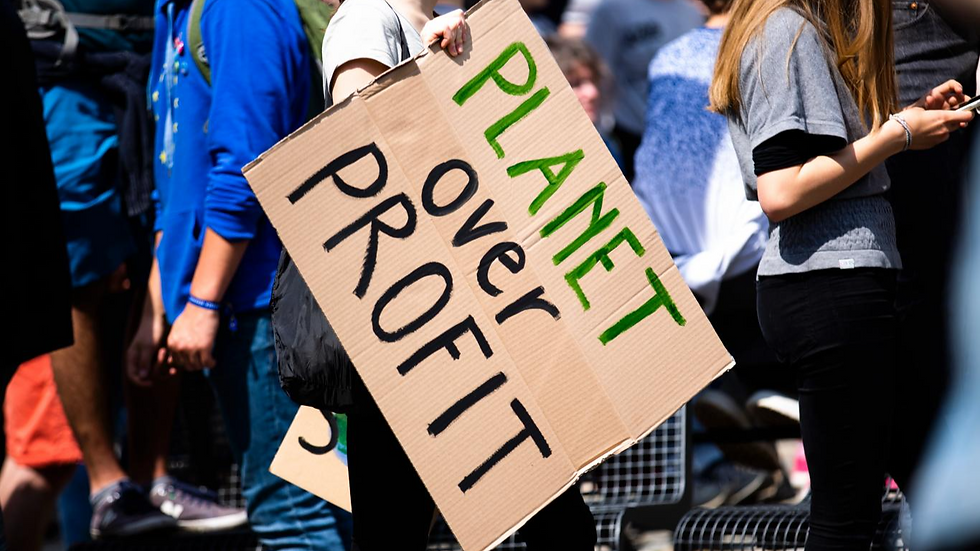FAST AND CHEAP BUT UNSUSTAINABLE = FAST FASHION BY SERENA KELLY
- rebecca46125
- Apr 29, 2023
- 3 min read

You’ve probably all heard of fast fashion and how it’s detrimental for the environment but I feel like until you understand it and know the alternatives, making a change in your shopping habits is unlikely. So in this blog post, I’m going to tell you how you can stay trendy and do it environmentally friendly.
I’m gonna be honest with you , I’m not the most environmentally friendly shopper ; don’t get me wrong I do try my best but if I see 30% off all items on Pretty Little Thing you will catch me there. So what I’m trying to say is I’m not asking you to only buy second hand items or make all your clothes, what I’m asking is that you become more aware of the effects of fast fashion and resist the urge to impulse buy in sales.
Speaking of my shopping habits, my favourite place to shop is Depop, yes it’s unlikely you’ll get next day delivery but what you will get are items that you know have caused less damage to the environment than buying firsthand. When you hear Depop what do you think? Because a lot of people don’t see just how good it is, it’s not just your grannies old clothes that’s she’s selling off, there’s million of clothes on there suited for everyone’s fashion aesthetic. Not only this but a lot of the time people are selling things brand new that they’ve bought and never worn so why damage the environment buying it brand new when you can get it sustainably from Depop. However, Depop isn’t just about the buying you can sell your own clothes, books, shoes you name it and you can sell it. So you can both buy clothes and make money all while being sustainable, what’s not to love?
Depop is just one example of a website/app where you can shop sustainably, some other examples are Etsy, H&M and ASOS offers a sustainable section alongside many more shops. Don’t forget your local charity shop they always have at least one good find.
But why do we need to do this? Well over time, and you’ve probably noticed it, fashion trends change and it can be hard to keep up with these trends. Resulting in quicker production times, cheaper clothes and more people shopping in and out of store, but these actions have serious impacts on the environment.
There’s a definition of fast fashion, which may help you understand 'it’s a model of mass-producing cheaply made ‘of-the-moment’ items sold at a lower price point'. It reflects the growing consumer desire for speed and value within retail; consumers can get their hands on a continuous cycle of trend-led clothing all year round.
These trend changes impact the environment through the use of cheap, toxic textile dyes, more clothes being disposed of by the consumer due to new trends, air pollution when importing the clothes and the list goes on. In Canada, the average person throws out 81 pounds of textiles annually, while North American’s send 9.5 million tons of clothing to landfill every year. The UK is not much better, we're the fourth largest textile waste producer in Europe - of the 3.1kg of textile waste per person each year about one quarter is incinerated and just over half is sent to landfill. These figures may alarm you but sadly it’s the harsh truth, which is why if we all do our bit we can gradually make change.
I hope this has been informative and shown you that there is hope for the environment and you don’t need to stop shopping to make changes. Although, it may not feel like you’re making huge changes if everyone does it and works together, change will happen.

Halloween may be known for costumes, but fashion enthusiasts know it’s also the perfect time to upgrade wardrobes. A brown suede jacket men from NY American Jacket for Halloween gift is ideal because it blends festive spirit with everyday wearability.
The uniqueness of Halloween inspired outfits from Leather Jacket Black for Halloween gift lies in the perfect balance between spooky vibes and wearable fashion. Unlike typical costumes that can only be worn once, these outfits are designed with high-quality materials and chic styles that last beyond Halloween.
I have read this blog and appreciate the perspective on the unsustainability of fast fashion. It’s important to make conscious choices for a more sustainable and ethical wardrobe. For mindful shopping in the UAE, visit SavePlus UAE.